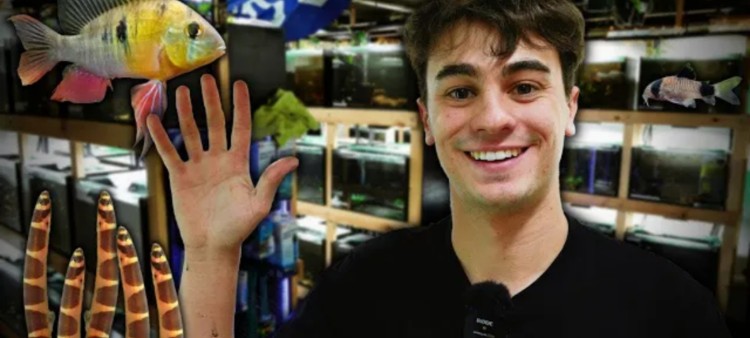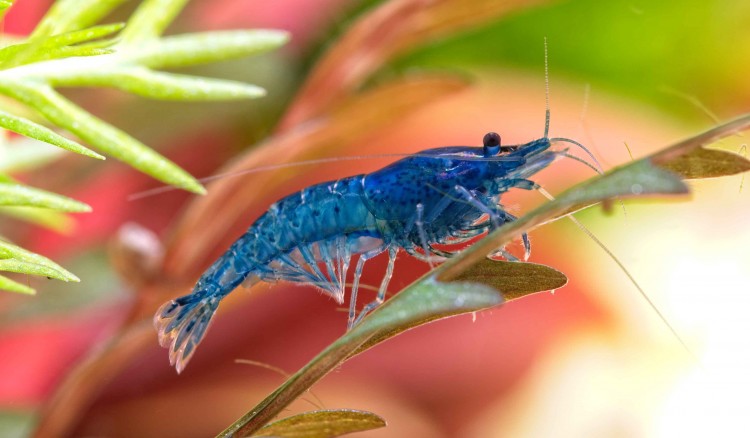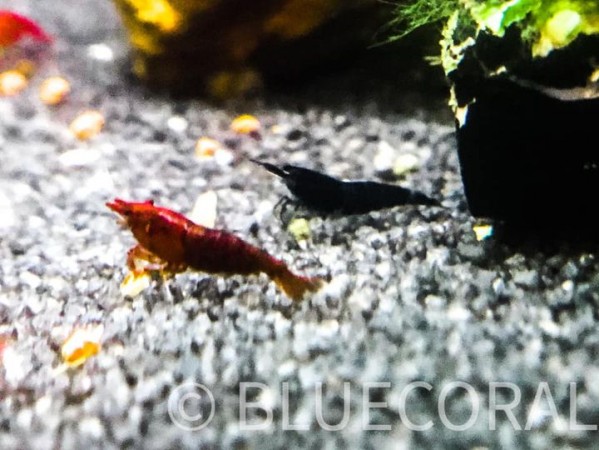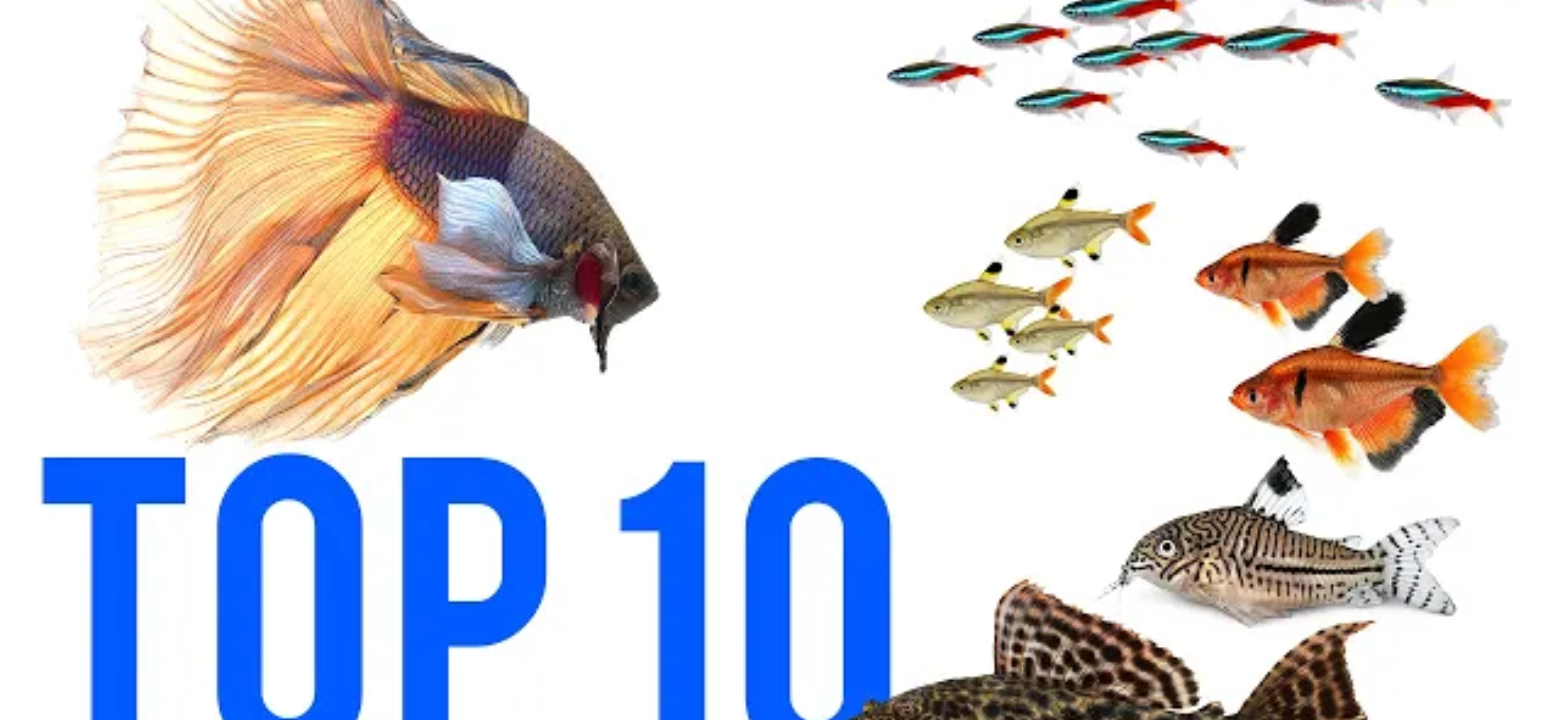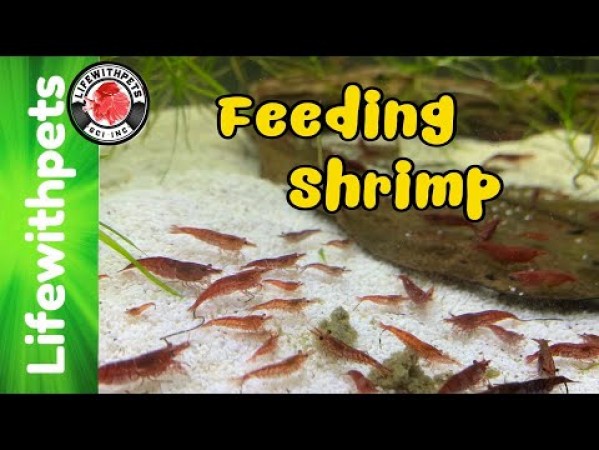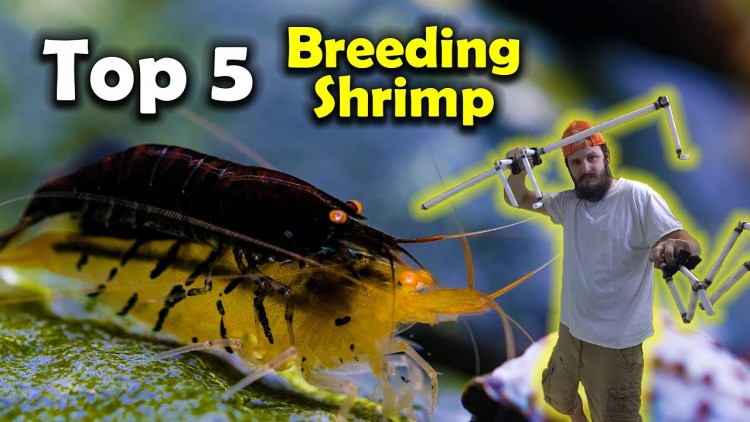- Name:
Grass Shrimp
(View AKA's) - Family: Palaeomonidae
- Species: Shrimp
- Scientific Name: Palaemonetes paludosus
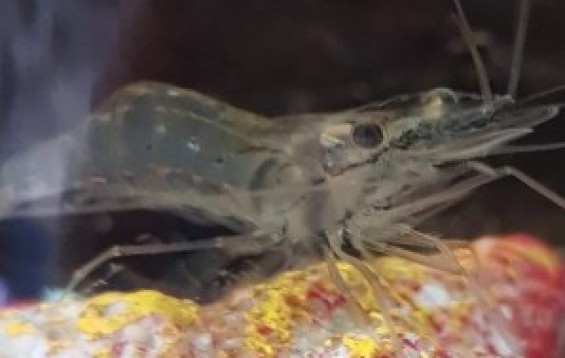

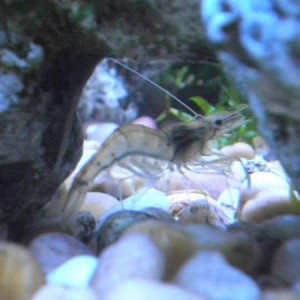
General info about Grass Shrimp
Grass Shrimp, are excellent scavengers and are very efficient aquarium cleaners that will actively search for any leftover food in your aquarium. They eat dead and decaying plant and animal life, breaking it down for other animals. This action helps keep the water clean and free of debris. Their transparent bodies and frenetic food-searching behavior make Grass Shrimp an exciting addition to your freshwater aquarium. The Grass Shrimp body is open but can camouflage itself by utilizing the pigment granules in its body.
Unlike related species of commercial shrimp, the grass shrimp is smaller and not generally harvested as a human food source. Ghost Shrimp are relatively inexpensive and are often purchased as “feeders” for larger more aggressive fish. Some Cichlids can eat Ghost Shrimp all day long. But Ghost Shrimp are more than a tasty snack. They are great aquarium cleaners and can be a lot of fun to watch.
Lifespan is around one year. Grass shrimp are tiny; 1 to 2 inches long and 1/4 inches wide. The adults are usually less than two inches long. The first two pair of legs on a grass shrimp looks like tiny claws. Their heads end in a pointed part called a rostrum. Their rostrums have teeth along the edges. You can see right through their transparent bodies. They only have a few spots of color on different parts of their bodies. Their heads are longer than the rest of their bodies.
In the natural habitat, using well-developed sense organs, grass shrimp can easily maneuver and swim in the water, but they are found most frequently crawling along the bottom. Like other crustaceans, grass shrimp can cast off legs and regenerate new ones. They grow by molting, shedding their exoskeletons and forming new, larger coverings. Between molts, a grass shrimp will eat almost anything, including its exoskeleton.
The gills of the grass shrimp are located under the carapace and are oxygenated by a particular organ near the mouth of the shrimp that pumps water over the gills. Their slender, elongated bodies are divided into two regions enclosed in the carapace: the head and the cephalothorax.
An established freshwater to a slightly brackish aquarium of at least 10 gallons with plenty of hiding places and a mature substrate are the ideal setup for the Grass Shrimp. There should be enough shelters in the tank, where the shrimps can hide. These may be some snags, flower pots, tubes or thick tank plants, for example, java moss. Hardy live plants can also be a good idea. Aquariums with lots of live plants are never “too clean” as the plants constantly shed plant matter into the water column. Ghost Shrimp seem to enjoy picking through the messiness and feasting on the parts they can eat.
Comfort temperature for ghost shrimps is 65-85°F. However, they can stand temperature decrease lower than 65°F. The most preferred temperature for shrimp is 75°F. Higher water temperature leads to an increase of ghost shrimp breeding and growth rate. At that higher temperature causes a decrease in the amount of oxygen dissolved in water. The upper-temperature limit acceptable for Glass shrimp is 30°C.
When buying shrimps, you should pay attention to their coloring and how active they are. A healthy shrimp is almost transparent and hyperdynamic. Inertness and milky coloring of the shrimp indicate that it was kept and transported at abnormal conditions and it is likely to die in the nearest future.
Ghost shrimp size allows it to be a good tank mate for most of the tank fishes. Although this species is slightly larger than other freshwater shrimp, it should still be housed with small peaceful fish that will not pose a threat of eating these shrimp. They don’t interact with tank fishes in any way, but if you keep shrimps with large and aggressive fishes (for instance, Oscar fish), the shrimps will be eliminated. Although it comes to small glass shrimps, the larger ones may be aggressive to them, especially if it’s not enough food for them. It is important to choose small-sized and non-predatory tank mates for a ghost shrimp. They may get aggressive and nasty toward each other if there are too many living together in a small space.
Grass Shrimp Diet & Nutrition
Grass shrimp are typically considered detritivores, feeding mainly upon dead or decaying plant matter. They break down detritus into tiny particles that are suspended in the water column, providing a rich food source for smaller organisms. However, their diets can consist of a wide variety of organisms. Grass shrimp are omnivores and feed on a range of plants and animals, including detritus, phytoplankton, algae, and other small invertebrates. In the aquarium, it consumes left-over foods as well. They are good little helpers in maintaining high-quality water and keeping your aquarium clean. If insufficient food is present, supplement with a quality flake food or pellet is necessary.
Grass shrimp are an excellent food source for many types of both freshwater and saltwater fish. Because these shrimp are so common and consume algae and seagrasses, they play an essential role in the ecology of the estuary.
In captivity, grass shrimp have been known to be cannibalistic, and will also predate on small polychaetes, oligochaetes, and nematodes (marine worms) in the wild.
It is essential to make sure that the food gets on the tank bottom and tank fish do not eat it in the middle water layer. Through their transparent bodies, you can easily see the food they have eaten being digested.
Determining Sex of Grass Shrimp
Ghost shrimp males and females can be easily distinguished. Firstly, the female has a greenish saddle on its back and/or eggs under its abdomen (they look like shining green spots). Secondly, these shrimps have a bulge on their back, and female shrimps have rather pronounced curved back.
Thirdly, another distinctive feature is shrimp size: female shrimps are larger than males. Length of adult glass shrimp female is about 2 inches, while the male is sometimes even smaller than 1.5 inches. However, both female and male are roughly equal in height.
Breeding & Spawning Grass Shrimp
Grass shrimp will readily breed in the aquarium if kept in large enough groups. The female carries the eggs, which appear as small green dots under the tail. If interested in raising the shrimp, remove the female to a different aquarium until the shrimp hatch. At that point, return the female to the main aquarium and feed the baby shrimp newly hatched brine shrimp, rotifers, or suitable liquid food.
Usually spawns in summer, when water temperatures warm. Females must molt before mating. The female carries her eggs in a brood pouch, visible through the shrimp’s transparent body. When the eggs hatch, these small shrimp go through a larval stage when they are called zoea, just like young blue crabs. Eggs hatch into free-swimming larvae after 12-20 days. The larvae go through a series of stages of development until they mature. This may last 1-2 months of life. As grass shrimp grow, they molt. They shed their outer skeleton. A new, softer skeleton takes its place. In a short period, the soft shell grows hard.
Glass Shrimp eggs are laid as a free-floating larva, and unlike other shrimp species, their larvae are not minute versions of their parents. This poses a challenge in their raising. Upon hatching the small larva requires powdered algae (Spirulina is the algae recommended for this) and must be in a different aquarium to keep them away from the predators. After a week the larvae will then change to resemble a minute version of their adult parents. The larvae cease to require that extensive care once they accomplished metamorphosis.
During the first days, the larva does not look like a shrimp. It is very tiny, and it swims in the water. It doesn’t even have legs, and it swims due to some annexa at the bottom of its tail. During its first days the shrimp larva feeds on infusorian and zooplankton, then it sheds its skin and starts looking like a tiny shrimp. Therefore you should use infusorian or other small-sized food to feed the juveniles. Also, you may put some fallen leaves on a tank bottom in advance since while they are rotting some microorganisms will appear and serve as food for glass shrimp juveniles. Put a bunch of java moss into the tank as well, since lots of microorganisms live there, too. After the larva sheds its skin, you can feed it with artificial food for shrimp juveniles.
Common Diseases with Grass Shrimp
At low temperatures, shrimp become more prone to various diseases. Tank water pH can be within 6.5-8.0. This range ensures a healthy life, coloring and survival rate. Neutral tap water is excellent to fill the tank with shrimps.
Grass Shrimp Origin
Grass Shrimp can be found throughout the western Atlantic Ocean and Gulf of Mexico. They are commonly found in salt marshes, seaweed, and eelgrass beds along the coast, mostly inhabiting New England's shallow coastal waters from Cape Cod south.
Caution with Grass Shrimp
The Glass Shrimp are ordinarily non-aggressive although there have been many reports of some that can get a bit antagonistic. Sometimes they can eat baby shrimp of other species or fish fry. Ghost shrimps may show aggression towards each other, especially to the smaller ones. Such behavior shows more if they live in a small tank. Therefore, a recommended number of shrimps in a tank – is one species for 4 liters of water.
Since most of the shrimps grow not larger than 1.5 inches (4 cm) and they don’t produce much waste in the tank, you should get the filter not for them, but mostly for fishes that live in the tank. The main thing you have to keep in mind is that juveniles are very small and they easily get sucked in with the flow of the water filter; therefore it’s better not to use an external one. An internal sponge filter without a case will be a perfect solution here. Though if you have a lot of fishes in the tank or if you have a large tank you can use an external filter since in a large tank the chances that small Glass shrimps get into the water filter are sufficiently lower.
Nitrites and ammonia level should be at zero level since ghost shrimp are very sensitive to nitrites and ammonia content in the water. As for the nitrates level – it should be as low as possible. Frequent water replacement and presence of tank plants can help to support low nitrates level in the tank water. Weekly water should be at least 30%.
Original Detail
| Name | Species | Family | Scientific Name | More Detail | Added by |
|---|---|---|---|---|---|
| Grass Shrimp | Shrimp | Palaeomonidae | Palaemonetes paludosus | Grass Shrimp, are excellent scavengers and are very efficient aquarium cleaners that will actively search for any leftover food in your aquarium. They eat dead and decaying plant and animal life, breaking it down for other animals. This action helps keep the water clean and free of debris. Their transparent bodies and frenetic food-searching behavior make Grass Shrimp an exciting addition to your freshwater aquarium. The Grass Shrimp body is open but can camouflage itself by utilizing the pigment granules in its body. Unlike related species of commercial shrimp, the grass shrimp is smaller and not generally harvested as a human food source. Ghost Shrimp are relatively inexpensive and are often purchased as “feeders” for larger more aggressive fish. Some Cichlids can eat Ghost Shrimp all day long. But Ghost Shrimp are more than a tasty snack. They are great aquarium cleaners and can be a lot of fun to watch. Lifespan is around one year. Grass shrimp are tiny; 1 to 2 inches long and 1/4 inches wide. The adults are usually less than two inches long. The first two pair of legs on a grass shrimp looks like tiny claws. Their heads end in a pointed part called a rostrum. Their rostrums have teeth along the edges. You can see right through their transparent bodies. They only have a few spots of color on different parts of their bodies. Their heads are longer than the rest of their bodies. In the natural habitat, using well-developed sense organs, grass shrimp can easily maneuver and swim in the water, but they are found most frequently crawling along the bottom. Like other crustaceans, grass shrimp can cast off legs and regenerate new ones. They grow by molting, shedding their exoskeletons and forming new, larger coverings. Between molts, a grass shrimp will eat almost anything, including its exoskeleton. The gills of the grass shrimp are located under the carapace and are oxygenated by a particular organ near the mouth of the shrimp that pumps water over the gills. Their slender, elongated bodies are divided into two regions enclosed in the carapace: the head and the cephalothorax. An established freshwater to a slightly brackish aquarium of at least 10 gallons with plenty of hiding places and a mature substrate are the ideal setup for the Grass Shrimp. There should be enough shelters in the tank, where the shrimps can hide. These may be some snags, flower pots, tubes or thick tank plants, for example, java moss. Hardy live plants can also be a good idea. Aquariums with lots of live plants are never “too clean” as the plants constantly shed plant matter into the water column. Ghost Shrimp seem to enjoy picking through the messiness and feasting on the parts they can eat. Comfort temperature for ghost shrimps is 65-85°F. However, they can stand temperature decrease lower than 65°F. The most preferred temperature for shrimp is 75°F. Higher water temperature leads to an increase of ghost shrimp breeding and growth rate. At that higher temperature causes a decrease in the amount of oxygen dissolved in water. The upper-temperature limit acceptable for Glass shrimp is 30°C. When buying shrimps, you should pay attention to their coloring and how active they are. A healthy shrimp is almost transparent and hyperdynamic. Inertness and milky coloring of the shrimp indicate that it was kept and transported at abnormal conditions and it is likely to die in the nearest future. Ghost shrimp size allows it to be a good tank mate for most of the tank fishes. Although this species is slightly larger than other freshwater shrimp, it should still be housed with small peaceful fish that will not pose a threat of eating these shrimp. They don’t interact with tank fishes in any way, but if you keep shrimps with large and aggressive fishes (for instance, Oscar fish), the shrimps will be eliminated. Although it comes to small glass shrimps, the larger ones may be aggressive to them, especially if it’s not enough food for them. It is important to choose small-sized and non-predatory tank mates for a ghost shrimp. They may get aggressive and nasty toward each other if there are too many living together in a small space. |
PalaciosAn |


